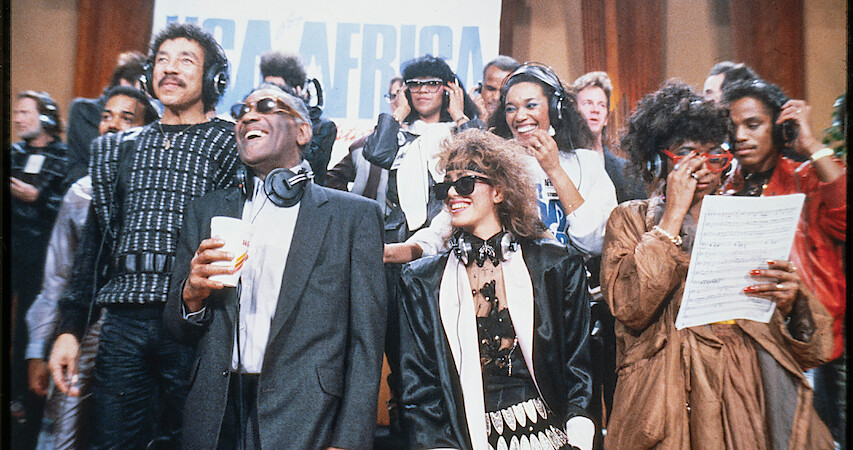Review: The Greatest Night in Pop
Get 40 of America’s biggest singers together in one night to record a charity single: what could go wrong? As it turns out, very little did, surprisingly, but not without the efforts of some extraordinary organisers who got the thing over the line – or on tape, as it were.
This intriguing documentary tells the story of the writing and recording in January 1985 of the hit single ‘We are the World’, the brainchild of legendary singer and civil rights activist Harry Belafonte and celebrity manager Ken Kragen. They aimed to create an American version of the song ‘Do They Know It’s Christmas?’, which Bob Geldof had organised in the UK the year before to raise millions for famine victims in Ethiopia. Michael Jackson offered to write the new song with his friend Lionel Richie; Richie and producer Quincy Jones became ringleaders of the recording circus.
Rather than record separately, the producers of ‘We are the World’ wanted, as with Geldof’s crew, a celebrity ‘choir’ assembled in the same place. With the performers involved, this was something of a logistical impossibility – as impossible, say, as ‘Dancin’ on the ceiling’ – except they had one shot – on the night of the American Music Awards, when most of the artists would be in Los Angeles.
Richie, who hosted the awards, and Jones herded the artists into A&M studios after the awards (the location a well-kept secret), where for the rest of the night they would record with a film crew on hand. Assembled were the likes of Jackson, Billy Joel, Willie Nelson, Diana Ross, Dionne Warwick, Bruce Springsteen, Tina Turner, and Bob Dylan. (Paul Simon quipped that if a bomb landed on the place, it would allow John Denver back to the top of the charts.) The organisers made the smart move of inviting only the singers, not their entourages, and Jones placed a sign over the studio door: ‘Check your ego at the door.’ It is fascinating seeing them mingling – one said it was like the first day of kindergarten.
The organisers wanted the biggest ego, Prince, but he didn’t lower himself to turn up. But for those that did, there are so many charming and humorous little scenes: Huey Lewis’s nerves (he took Prince’s place), whacky Cindy Lauper needing to remove her rattling jewellery, Ray Charles playing a jazz version of the song on the piano in between proper takes. They were the cream of bloated 80s pop, but they were also a bunch of people nervously asking each other for autographs, trying to do something positive.
Stevie Wonder is both villain and hero: Jones knew with so little time but so many people and potential opinions, the recording process had to be rigid, but Wonder nearly ran it off the rails by arguing that they should put some Swahili in the song. He later redeemed himself by taking the clearly bewildered Bob Dylan aside and shepherding him through his vocal. Dylan’s few lines in his reedy, distinctive style ended up adding a surprising poignancy that is different to the other singers’ aerobic efforts.
The song itself is somewhat daft, in typical overblown Jackson style (and not quite as clever as the UK version). The gathering would prove a template for later charity-raising efforts, and was easily parodied, such as in an episode of The Simpsons, when Krusty the Clown and Sting sing ‘We’re Sending our Love Down the Well’. But the pragmatic Springsteen, in a recent interview included in the documentary, said that whatever the song’s artistic merits, it was a ‘tool’, and it did its job. $63 million was raised.

The Greatest Night in Pop is now streaming on Netflix
Nick Mattiske blogs on books at coburgreviewofbooks.wordpress.com and is the illustrator of Thoughts That Feel So Big.













